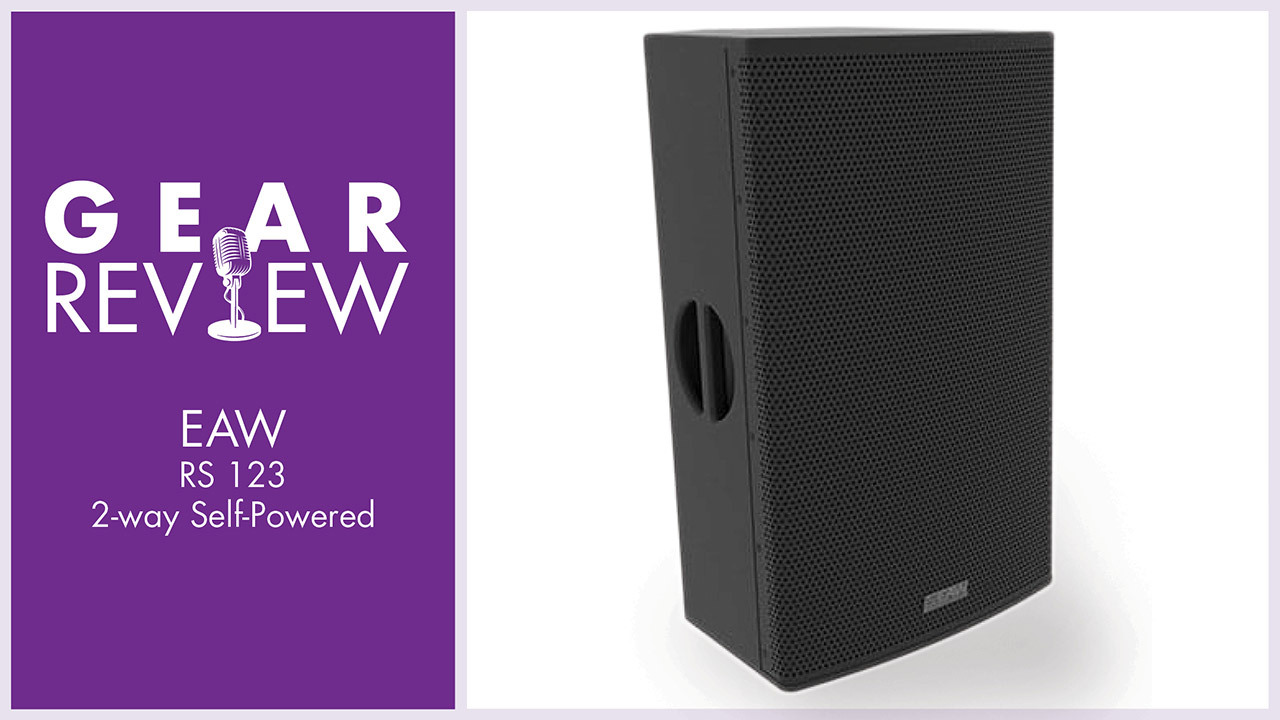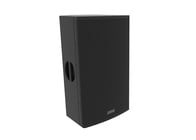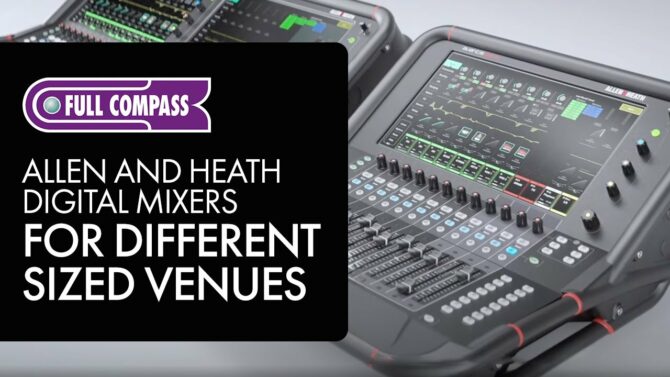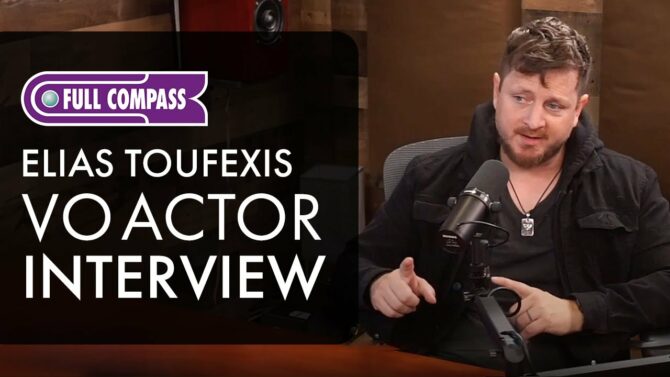Few would consider powered loudspeakers an endangered species, so it’s always interesting to see what a manufacturer brings to the party. EAW (Eastern Acoustic Works) doesn’t have a high consumer profile; their products aren’t exactly entry-level (you may remember the EAW system behind the Tom Petty tour). So they don’t make the kind of speaker where you go into a music store and walk out with your purchase. Nor are they in a race to the bottom with their price points, because you’re paying for touring-grade, high-end speakers with sonic clarity. They also lack the harsh quality found occasionally in speakers whose goal is to pump out lots of level.
But while users give EAW high marks for sound, their offerings have always been more about production and touring than portability. With speakers trending toward lighter-weight solutions, EAW added the RS Definition:
Definition:
(Recommended Standard) A standard issued by the EIA, a now-defunct trade organization whose duties have been absorbed by other organizations. See EIA. series with the intention of preserving the sound while shaving the weight. However, it doesn’t shave on specs—the RS speakers are aimed squarely at pro applications like houses of worship, rental and staging, installations, and corporate AV.
What’s in the Cabinet
The RS123 incorporates a 12-inch low-frequency Definition:
Definition:
A value, expressed in Hertz, that indicates how many cycles of a periodic signal occur in one second. speaker and 3-inch voice coil/1.4-inch exit high-frequency compression driver Definition:
Definition:
A loudspeaker that compress is motion into a small space to feed the throat of a horn. (normally found at higher price points), in a 42 pound, wooden enclosure with M10 threaded suspension points. It’s 25.9 inches high, 14.5 inches wide, and 15 inches deep, which is par for the course with this type of product. One side is angled (Fig. 1) to allow for use as a wedge floor monitor.

Figure 1: Note the RS123’s wedge-friendly angled side.
The horn provides a 60° by 90° coverage pattern, but because it’s possible to rotate the horn 90°, the speaker can provide the same coverage with horizontal or vertical mounting. Making this change isn’t hard to do; you remove four Philips head screws, rotate the horn, then screw it back in again. Also note that both drivers are field-replaceable, and you can swap out the entire amplifier Definition:
Definition:
1. A device that increases the voltage or power of a signal. 2. In music performance, a device such as a guitar amplifier that includes speakers and controls to increase the sound level of acoustic or electric instruments. module if needed. Hopefully you won’t have to do any field repair (and the speakers do have a 6-year warranty), but it’s reassuring to know you can.
The onboard, biamplified Class D power amp Definition:
Definition:
Abbreviation for either Ampere or Amplifier. (with an 800 Hz Definition:
Definition:
See Hertz. crossover Definition:
Definition:
A filter or set of filters that divide audio signals by frequency. Crossovers, whether active or passive, are common in speaker designs to direct high and low frequencies to their respective drivers. Crossovers are also used in multiband signal processors, like multiband dynamics or multiband distortion. ) provides 1500 Watts peak, and as is common these days, includes DSP Definition:
Definition:
1. DSP (Digital Signal Processor): An integrated circuit or device that mathematically alters sound or video signals. 2. DSP (Digital Signal Processing): The technique of converting an analog signal into digital data, manipulating that data, then producing an analog output that reflects the changes caused by these manipulations done in the digital domain. for cabinet tuning. Claimed max SPL Definition:
Definition:
See Sound Pressure Level. is 138 dB Definition:
Definition:
1. A deciBel is a logarithmic ratio between two quantities, and is a nonlinear measurement that mimics human perception. 2. A unit expressing sound levels relative to a nominal level just audible by the average human ear, and equal to 1/10th of a Bel.. The connectors are electronically balanced XLR and ¼” TRS Definition:
Definition:
(Tip Ring Sleeve) Phone style connector. 3 conductor (Stereo) originally 1/4" diameter, also 1/8" and smaller and the TT style for patchbays. Used for headphones and patching. input jacks (separate jacks, not combo), and XLR for thru. You can’t use both input jacks simultaneously, so don’t expect to mix two signal sources together.
Neutrik PowerCON Definition:
Definition:
AC Power connector, designed by Neutrik, and rated at 20 Amps. connectors (cable included) handle the AC Definition:
Definition:
AC (Alternating Current): Current whose electrical flow alternates between positive and negative quadrants, and whose magnitude varies periodically. Alternating current is used in most commercial power transmission, and is also the basis of audio or video signals.. You can loop Definition:
Definition:
1. To re-record dialog over video. See ADR. 2. To replay a portion of audio or video content. 3. (sampling) To repeat a section of a waveform so that it can sustain indefinitely. 3. To repeat a phrase or section of sound multiple times within a composition or recording. power from one enclosure to another (Fig. 2), up to a maximum of four enclosures, while a circuit breaker protects the looped connection.

Figure 2: RS123 power connection section; the loop connector is white.
Controls and Electronics
As with most products designed for touring and installations, the assumption is that any signal manipulation and processing will occur before the signal hits the speaker, so the control panel is minimal. In addition to the aforementioned connections, there’s a Level control, recessed Line/Mic slide switch so it’s impossible to switch by accident, and three LED Definition:
Definition:
LED (Light-Emitting Diode): A semiconductor light generator used in displays, television, pointers and for general illumination. It is a low-power replacement for incandescent lamps. indicators (Fig. 3).

Figure 3: The control section and jack field is recessed, so the plugs don’t stick out, and it’s difficult to brush up against the controls accidentally.
A status LED is normally lit, but blinks if the thermal protection mode trips, which requires power-cycling the speaker after it cools. (I was not able to confirm this, because I couldn’t drive the speaker long enough and hard enough to cause it to shut down.) A signal LED lets you know signal is reaching the speaker, and a Limit indicator blinks red if EAW’s DynO limiting process has been engaged. This indicator also lights solid if the speaker is clipping Definition:
Definition:
Distortion caused by overdriving a signal through an electronic device, to a level beyond which no more headroom is available.; if all three LEDs flash simultaneously, there’s a problem.
Finally, a Main/Monitor button chooses two voicing. Main is for tripod or hung mountings, while Monitor is for floor placement when used as a wedge. This voicing reduces low-frequency coupling to the floor.
Techno Mojo
EAW does a few things differently from the norm. The DynO process isn’t really like conventional limiting that works solely on amplitude Definition:
Definition:
The volume (Amount) of a signal, electrical, optical or acoustic., but uses limiting algorithms that take into account the headroom Definition:
Definition:
1. The safety margin for an electronic signal that accommodates peak signals without overload. It is the difference (in dB) between normal operating levels (0-VU) and the clipping (overload) point. 2. The space between a subjects head or top and the top edge of a screen frame. of both the amp and speakers, and applies frequency-based limiting.
Also, EAW uses the speaker’s DSP to implement what they call EAW Focusing. In a nutshell, this compensates for phase and resonance Definition:
Definition:
1. (physics) The phenomenon of a signal's amplitude increasing when its frequency is close to the natural frequency of a system of which it is a part, or on which it acts. 2. (filter) A control that increases amplitude at whatever frequency is selected. issues that would otherwise degrade transient response Definition:
Definition:
The ability for a piece of equipment to follow a fast-rising waveform, and reproduce it accurately.. The improvement wasn’t apparent to me only at high levels; lower levels sounded more like studio monitor voicings than traditional “PA speakers.”
The Sound
Frequency response is given as 47 Hz to 20 kHz Definition:
Definition:
kHz (Kilohertz): 1,000 Hertz, or one thousand cycles per second., and within this range, the frequency response Definition:
Definition:
The range of frequencies that an audio, video or data device can pass. stays within -10 dB SPL of the average SPL. For most applications, the bass response should be more than sufficient. For DJs and those who want the low end to pack a serious wallop (e.g., for cinematic-level presentations, theater, or exhibitions), you’d probably want to add a subwoofer Definition:
Definition:
A low-frequency speaker, typically optimized for response below 120 Hz, for augmenting full-range sound systems.. EAW’s RS118 (with an 18” driver) is designed as a companion subwoofer for the RS123, which can pole-mount above the sub.
There’s a certain kind of precision which may be due to the EAW Focusing technology, or some other design factor, but there’s a definite clarity and lack of smearing. Transients are crisp, and the bass is tight, rather than muddy or indistinct. These are technologically advanced speakers, and you can hear it in the sound.
Overall, EAW has a high-end reputation, and that’s where they’ve aimed their products. With the RS series, they’ve expanded their line with speakers that show the EAW heritage, but are also more portable and can reach a wider, albeit still pro-oriented, market. Yes, they cost a bit more—but there’s a good reason for that, and one that will likely attract new converts.












